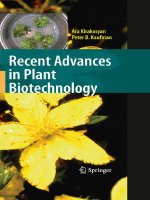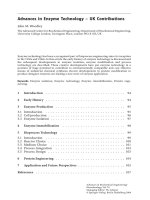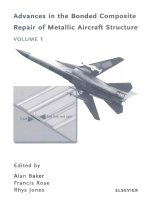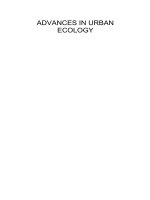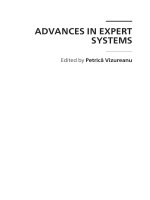advances in fluid catalytic cracking
Bạn đang xem bản rút gọn của tài liệu. Xem và tải ngay bản đầy đủ của tài liệu tại đây (5.91 MB, 410 trang )
Advances in
Fluid Catalytic Cracking
Testing, Characterization,
and Environmental Regulations
CHEMICAL INDUSTRIES
A Series of Reference Books and Textbooks
Founding Editor
HEINZ HEINEMANN
Berkeley, California
Series Editor
JAMES G. SPEIGHT
CD & W, Inc.
Laramie, Wyoming
1. Fluid Catalytic Cracking with Zeolite Catalysts, Paul B. Venuto
and E. Thomas Habib, Jr.
2. Ethylene: Keystone to the Petrochemical Industry, Ludwig Kniel,
Olaf Winter, and Karl Stork
3. The Chemistry and Technology of Petroleum, James G. Speight
4. The Desulfurization of Heavy Oils and Residua, James G. Speight
5. Catalysis of Organic Reactions, edited by William R. Moser
6. Acetylene-Based Chemicals from Coal and Other Natural Resources,
Robert J. Tedeschi
7. Chemically Resistant Masonry, Walter Lee Sheppard, Jr.
8. Compressors and Expanders: Selection and Application for the Process
Industry, Heinz P. Bloch, Joseph A. Cameron, Frank M. Danowski, Jr.,
Ralph James, Jr., Judson S. Swearingen, and Marilyn E. Weightman
9. Metering Pumps: Selection and Application, James P. Poynton
10. Hydrocarbons from Methanol, Clarence D. Chang
11. Form Flotation: Theory and Applications, Ann N. Clarke
and David J. Wilson
12. The Chemistry and Technology of Coal, James G. Speight
13. Pneumatic and Hydraulic Conveying of Solids, O. A. Williams
14. Catalyst Manufacture: Laboratory and Commercial Preparations,
Alvin B. Stiles
15. Characterization of Heterogeneous Catalysts, edited by Francis Delannay
16. BASIC Programs for Chemical Engineering Design, James H. Weber
1 7. Catalyst Poisoning, L. Louis Hegedus and Robert W. McCabe
18. Catalysis of Organic Reactions, edited by John R. Kosak
19. Adsorption Technology: A Step-by-Step Approach to Process Evaluation
and Application, edited by Frank L. Slejko
20. Deactivation and Poisoning of Catalysts, edited by Jacques Oudar
and Henry Wise
21. Catalysis and Surface Science: Developments in Chemicals
from Methanol, Hydrotreating of Hydrocarbons, Catalyst Preparation,
Monomers and Polymers, Photocatalysis and Photovoltaics, edited by
Heinz Heinemann and Gabor A. Somorjai
22. Catalysis of Organic Reactions, edited by Robert L. Augustine
23. Modern Control Techniques for the Processing Industries,T. H. Tsai,
J. W. Lane, and C. S. Lin
24. Temperature-Programmed Reduction for Solid Materials
Characterization, Alan Jones and Brian McNichol
25. Catalytic Cracking: Catalysts, Chemistry, and Kinetics,
Bohdan W. Wojciechowski and Avelino Corma
26. Chemical Reaction and Reactor Engineering, edited by J. J. Carberry
and A. Varma
2 7. Filtration: Principles and Practices: Second Edition, edited by
Michael J. Matteson and Clyde Orr
28. Corrosion Mechanisms, edited by Florian Mansfeld
29. Catalysis and Surface Properties of Liquid Metals and Alloys,
Yoshisada Ogino
30. Catalyst Deactivation, edited by Eugene E. Petersen and Alexis T. Bell
31. Hydrogen Effects in Catalysis: Fundamentals and Practical Applications,
edited by Zoltán Paál and P. G. Menon
32. Flow Management for Engineers and Scientists,
Nicholas P. Cheremisinoff and Paul N. Cheremisinoff
33. Catalysis of Organic Reactions, edited by Paul N. Rylander,
Harold Greenfield, and Robert L. Augustine
34. Powder and Bulk Solids Handling Processes: Instrumentation
and Control, Koichi Iinoya, Hiroaki Masuda, and Kinnosuke Watanabe
35. Reverse Osmosis Technology: Applications for High-Purity-Water
Production, edited by Bipin S. Parekh
36. Shape Selective Catalysis in Industrial Applications, N. Y. Chen,
William E. Garwood, and Frank G. Dwyer
3 7. Alpha Olefins Applications Handbook, edited by George R. Lappin
and Joseph L. Sauer
38. Process Modeling and Control in Chemical Industries, edited by
Kaddour Najim
39. Clathrate Hydrates of Natural Gases, E. Dendy Sloan, Jr.
40. Catalysis of Organic Reactions, edited by Dale W. Blackburn
41. Fuel Science and Technology Handbook, edited by James G. Speight
42. Octane-Enhancing Zeolitic FCC Catalysts, Julius Scherzer
43. Oxygen in Catalysis, Adam Bielanski and Jerzy Haber
44. The Chemistry and Technology of Petroleum: Second Edition, Revised
and Expanded, James G. Speight
45. Industrial Drying Equipment: Selection and Application,
C. M. van’t Land
46. Novel Production Methods for Ethylene, Light Hydrocarbons,
and Aromatics, edited by Lyle F. Albright, Billy L. Crynes,
and Siegfried Nowak
4 7. Catalysis of Organic Reactions, edited by William E. Pascoe
48. Synthetic Lubricants and High-Performance Functional Fluids,
edited by Ronald L. Shubkin
49. Acetic Acid and Its Derivatives, edited by Victor H. Agreda
and Joseph R. Zoeller
50. Properties and Applications of Perovskite-Type Oxides, edited by
L. G. Tejuca and J. L. G. Fierro
51. Computer-Aided Design of Catalysts, edited by E. Robert Becker
and Carmo J. Pereira
52. Models for Thermodynamic and Phase Equilibria Calculations,
edited by Stanley I. Sandler
53. Catalysis of Organic Reactions, edited by John R. Kosak
and Thomas A. Johnson
54. Composition and Analysis of Heavy Petroleum Fractions,
Klaus H. Altgelt and Mieczyslaw M. Boduszynski
55. NMR Techniques in Catalysis, edited by Alexis T. Bell and Alexander Pines
56. Upgrading Petroleum Residues and Heavy Oils, Murray R. Gray
5 7. Methanol Production and Use, edited by Wu-Hsun Cheng
and Harold H. Kung
58. Catalytic Hydroprocessing of Petroleum and Distillates, edited by
Michael C. Oballah and Stuart S. Shih
59. The Chemistry and Technology of Coal: Second Edition, Revised
and Expanded, James G. Speight
60. Lubricant Base Oil and Wax Processing, Avilino Sequeira, Jr.
61. Catalytic Naphtha Reforming: Science and Technology, edited by
George J. Antos, Abdullah M. Aitani, and José M. Parera
62. Catalysis of Organic Reactions, edited by Mike G. Scaros
and Michael L. Prunier
63. Catalyst Manufacture, Alvin B. Stiles and Theodore A. Koch
64. Handbook of Grignard Reagents, edited by Gary S. Silverman
and Philip E. Rakita
65. Shape Selective Catalysis in Industrial Applications: Second Edition,
Revised and Expanded, N. Y. Chen, William E. Garwood,
and Francis G. Dwyer
66. Hydrocracking Science and Technology, Julius Scherzer and A. J. Gruia
6 7. Hydrotreating Technology for Pollution Control: Catalysts, Catalysis,
and Processes, edited by Mario L. Occelli and Russell Chianelli
68. Catalysis of Organic Reactions, edited by Russell E. Malz, Jr.
69. Synthesis of Porous Materials: Zeolites, Clays, and Nanostructures,
edited by Mario L. Occelli and Henri Kessler
70. Methane and Its Derivatives, Sunggyu Lee
71. Structured Catalysts and Reactors, edited by Andrzej Cybulski
and Jacob A. Moulijn
72. Industrial Gases in Petrochemical Processing, Harold Gunardson
73. Clathrate Hydrates of Natural Gases: Second Edition, Revised
and Expanded, E. Dendy Sloan, Jr.
74. Fluid Cracking Catalysts, edited by Mario L. Occelli and Paul O’Connor
75. Catalysis of Organic Reactions
, edited by Frank E. Herkes
76. The Chemistry and Technology of Petroleum: Third Edition, Revised
and Expanded, James G. Speight
7 7. Synthetic Lubricants and High-Performance Functional Fluids:
Second Edition, Revised and Expanded, Leslie R. Rudnick
and Ronald L. Shubkin
78. The Desulfurization of Heavy Oils and Residua, Second Edition, Revised
and Expanded, James G. Speight
79. Reaction Kinetics and Reactor Design: Second Edition, Revised
and Expanded, John B. Butt
80. Regulatory Chemicals Handbook, Jennifer M. Spero, Bella Devito,
and Louis Theodore
81. Applied Parameter Estimation for Chemical Engineers, Peter Englezos
and Nicolas Kalogerakis
82. Catalysis of Organic Reactions, edited by Michael E. Ford
83. The Chemical Process Industries Infrastructure: Function and Economics,
James R. Couper, O. Thomas Beasley, and W. Roy Penney
84. Transport Phenomena Fundamentals, Joel L. Plawsky
85. Petroleum Refining Processes, James G. Speight and Baki Özüm
86. Health, Safety, and Accident Management in the Chemical Process
Industries, Ann Marie Flynn and Louis Theodore
8 7. Plantwide Dynamic Simulators in Chemical Processing and Control,
William L. Luyben
88. Chemical Reactor Design, Peter Harriott
89. Catalysis of Organic Reactions, edited by Dennis G. Morrell
90. Lubricant Additives: Chemistry and Applications, edited by
Leslie R. Rudnick
91. Handbook of Fluidization and Fluid-Particle Systems, edited by
Wen-Ching Yang
92. Conservation Equations and Modeling of Chemical and Biochemical
Processes, Said S. E. H. Elnashaie and Parag Garhyan
93. Batch Fermentation: Modeling, Monitoring, and Control, Ali Çinar,
Gülnur Birol, Satish J. Parulekar, and Cenk Ündey
94. Industrial Solvents Handbook, Second Edition, Nicholas P. Cheremisinoff
95. Petroleum and Gas Field Processing, H. K. Abdel-Aal, Mohamed Aggour,
and M. Fahim
96. Chemical Process Engineering: Design and Economics, Harry Silla
9 7. Process Engineering Economics, James R. Couper
98. Re-Engineering the Chemical Processing Plant: Process Intensification,
edited by Andrzej Stankiewicz and Jacob A. Moulijn
99. Thermodynamic Cycles: Computer-Aided Design and Optimization,
Chih Wu
100. Catalytic Naphtha Reforming: Second Edition, Revised and Expanded,
edited by George T. Antos and Abdullah M. Aitani
101. Handbook of MTBE and Other Gasoline Oxygenates, edited by
S. Halim Hamid and Mohammad Ashraf Ali
102. Industrial Chemical Cresols and Downstream Derivatives,
Asim Kumar Mukhopadhyay
103. Polymer Processing Instabilities: Control and Understanding,
edited by Savvas Hatzikiriakos and Kalman B. Migler
104. Catalysis of Organic Reactions, John Sowa
105. Gasification Technologies: A Primer for Engineers and Scientists,
edited by John Rezaiyan and Nicholas P. Cheremisinoff
106. Batch Processes, edited by Ekaterini Korovessi and Andreas A. Linninger
10 7. Introduction to Process Control, Jose A. Romagnoli
and Ahmet Palazoglu
108. Metal Oxides: Chemistry and Applications, edited by J. L. G. Fierro
109. Molecular Modeling in Heavy Hydrocarbon Conversions,
Michael T. Klein, Ralph J. Bertolacini, Linda J. Broadbelt, Ankush Kumar
and Gang Hou
110 . Structured Catalysts and Reactors, Second Edition, edited by
Andrzej Cybulski and Jacob A. Moulijn
111. Synthetics, Mineral Oils, and Bio-Based Lubricants: Chemistry
and Technology, edited by Leslie R. Rudnick
11 2. Alcoholic Fuels, edited by Shelley Minteer
11 3. Bubbles, Drops, and Particles in Non-Newtonian Fluids, Second Edition,
R. P. Chhabra
114 . The Chemistry and Technology of Petroleum, Fourth Edition,
James G. Speight
11 5. Catalysis of Organic Reactions, edited by Stephen R. Schmidt
11 6. Process Chemistry of Lubricant Base Stocks, Thomas R. Lynch
11 7. Hydroprocessing of Heavy Oils and Residua, edited by
James G. Speight and Jorge Ancheyta
11 8. Chemical Process Performance Evaluation, Ali Cinar, Ahmet Palazoglu,
and Ferhan Kayihan
119 . Clathrate Hydrates of Natural Gases, Third Edition, E. Dendy Sloan
and Carolyn Koh
120. Interfacial Properties of Petroleum Products, Lilianna Z. Pillon
121. Process Chemistry of Petroleum Macromolecules, Irwin A. Wiehe
122. The Scientist or Engineer as an Expert Witness, James G. Speight
123. Catalysis of Organic Reactions, edited by Michael L. Prunier
124. Lubricant Additives: Chemistry and Applications, Second Edition,
edited by Leslie R. Rudnick
125. Chemical Reaction Engineering and Reactor Technology,
Tapio O. Salmi, Jyri-Pekka Mikkola, and Johan P. Warna
126. Asphaltenes: Chemical Transformation during Hydroprocessing of Heavy
Oils, Jorge Ancheyta, Fernando Trejo, and Mohan Singh Rana
1 2 7. Transport Phenomena Fundamentals, Second Edition, Joel Plawsky
128. Advances in Fischer-Tropsch Synthesis, Catalysts, and Catalysis,
edited by Burton H. Davis and Mario L. Occelli
129. Advances in Fluid Catalytic Cracking: Testing, Characterization,
and Environmental Regulations, edited by Mario L. Occelli
Edited by
Mario L. Occelli
Georgia Institute of Technology
Atlanta, Georgia, U.S.A.
Advances in
Fluid Catalytic Cracking
Testing, Characterization,
and Environmental Regulations
CRC Press is an imprint of the
Taylor & Francis Group, an informa business
Boca Raton London New York
CRC Press
Taylor & Francis Group
6000 Broken Sound Parkway NW, Suite 300
Boca Raton, FL 33487-2742
© 2010 by Taylor and Francis Group, LLC
CRC Press is an imprint of Taylor & Francis Group, an Informa business
No claim to original U.S. Government works
Printed in the United States of America on acid-free paper
10 9 8 7 6 5 4 3 2 1
International Standard Book Number: 978-1-4200-6254-0 (Hardback)
This book contains information obtained from authentic and highly regarded sources. Reasonable efforts have been
made to publish reliable data and information, but the author and publisher cannot assume responsibility for the
validity of all materials or the consequences of their use. The authors and publishers have attempted to trace the
copyright holders of all material reproduced in this publication and apologize to copyright holders if permission to
publish in this form has not been obtained. If any copyright material has not been acknowledged please write and let
us know so we may rectify in any future reprint.
Except as permitted under U.S. Copyright Law, no part of this book may be reprinted, reproduced, transmitted,
or utilized in any form by any electronic, mechanical, or other means, now known or hereafter invented, includ-
ing photocopying, microfilming, and recording, or in any information storage or retrieval system, without written
permission from the publishers.
For permission to photocopy or use material electronically from this work, please access www.copyright.com
( or contact the Copyright Clearance Center, Inc. (CCC), 222 Rosewood Drive, Danvers,
MA 01923, 978-750-8400. CCC is a not-for-profit organization that provides licenses and registration for a variety
of users. For organizations that have been granted a photocopy license by the CCC, a separate system of payment
has been arranged.
Trademark Notice: Product or corporate names may be trademarks or registered trademarks, and are used only for
identification and explanation without intent to infringe.
Library of Congress Cataloging-in-Publication Data
Advances in fluid catalytic cracking : testing, characterization, and environmental regulations
/ editor, Mario L. Occelli.
p. cm. (Chemical industries)
Summary: “Since 1987, the Petroleum Division of the American Chemical Society (ACS)
has sponsored at three years intervals an international symposium on fluid cracking catalysts
technology. Papers presented at these symposia have been published in book form in seven
separate volumes. The recent global economic downturn together with the H1N1 flu scare,
have limited participation and contributions to the recent 238th ACS meeting in Washington
DC, August 2009. As a result the present volume contains, in addition to research presented at
the symposium, several invited papers” Provided by publisher.
Includes bibliographical references and index.
ISBN 978-1-4200-6254-0 (hardback)
1. Catalytic cracking Congresses. I. Occelli, Mario L., 1942-
TP690.4,A38 2010
665.5’33 dc22 2010040232
Visit the Taylor & Francis Web site at
and the CRC Press Web site at
ix
Contents
Preface xi
Contributors xiii
1Chapter Maximizing FCC Light Cycle Oil by Heavy Cycle Oil Recycle 1
Hongbo Ma, Ruizhong Hu, Larry Langan, David Hunt, and
Wu-Cheng Cheng
2Chapter A New Catalytic Process Approach for Low Aromatic LCO 23
William Gilbert, Edisson Morgado Jr., and Marco Antonio
Santos Abreu
3Chapter Catalyst Evaluation Using an ARCO Pilot Unit on North Sea
Atmospheric Residue 37
Sven-Ingvar Andersson and Trond Myrstad
4Chapter Pilot Unit Test of Residue Type Catalysts on North Sea
Atmospheric Residue 63
Sven-Ingvar Andersson and Trond Myrstad
5Chapter Novel FCC Catalysts and Processing Methods for Heavy Oil
Conversion and Propylene Production 77
Long Jun, Da Zhijian, Song Haitao, Zhu Yuxia, and Tian Huiping
6Chapter Improving the Protability of the FCCU 91
Warren Letzsch, Chris Santner, and Steve Tragesser
7Chapter Troubleshooting Complex FCCU Issues 101
Jack R. Wilcox
8Chapter Catalytic Cracking for Integration of Renery and
Steam Crackers 119
Dilip Dharia, Andy Batachari, Prashant Naik, and Colin Bowen
9Chapter Advanced Articial Deactivation of FCC Catalysts 127
A. C. Psarras, E. F. Iliopoulou, and A. A. Lappas
x Contents
1Chapter 0 Coke Characterization by Temperature-Programmed Oxidation
of Spent FCC Catalysts That Process Heavy Feedstock 143
William Gaona, Diana Duarte, Carlos Medina, and Luis Almanza
1Chapter 1 The Effect of Cohesive Forces on Catalyst Entrainment in
Fluidized Bed Regenerators 155
Ray Cocco, Roy Hays, S. B. Reddy Karri, and Ted M. Knowlton
1Chapter 2 Application of
1
H-NMR for Fluid Catalytic Cracking Feed
Characterization 173
Dariusz S. Orlicki, Uriel Navarro, Michelle Ni, and Larry Langan
1Chapter 3 Surface Acid–Base Characterization of Containing Group IIIA
Catalysts by Using Adsorption Microcalorimetry 199
Georgeta Postole and Aline Auroux
1Chapter 4 EPA Consent Decree Implementation 257
Jeffrey A. Sexton
1Chapter 5 FCC Emission Reduction Technologies through Consent
Decree Implementation: Heat Balance Effects on Emissions 271
Jeffrey A. Sexton
1Chapter 6 FCC Emission Reduction Technologies through Consent
Decree Implementation: FCC SO
x
Emissions and Controls 291
Jeffrey A. Sexton
1Chapter 7 FCC Emission Reduction Technologies through Consent
Decree Implementation: FCC NO
x
Emissions and Controls 315
Jeffrey A. Sexton
1Chapter 8 FCC Emission Reduction Technologies through Consent
Decree Implementation: FCC PM Emissions and Controls 351
Jeffrey A. Sexton
Index 379
xi
Preface
Since 1987, the Petroleum Division of the American Chemical Society (ACS)
has sponsored an international symposium on uid cracking catalysts technology
at three-year intervals. Papers presented at these symposia have been published
in book form in seven separate volumes. The recent global economic downturn
together with the H1N1 u scare have limited participation and contributions to the
recent 238th ACS meeting in Washington, DC in August 2009. As a result the pres-
ent volume contains, in addition to research presented at the symposium, several
invited papers.
To reners, changes and challenges are everyday occurrences. After over-
coming oil supply limitations from Middle East politics and the obstacles of
fuel reformulations and rising crude prices, the industry is now facing an ever-
growing number of mandates by governmental bodies worldwide at a time when
there is a decline in demand for transportation fuels based on traditional fossil
feedstocks. As a result, feeds, processes, and therefore catalysts will have to
change.
The reners’ efforts to conform to ever stringent environmental laws and use of
fuels derived from renewable sources are evident in chapters reporting FCC emis-
sion reduction technologies. Today, modern spectroscopic techniques continue to be
essential to the understanding of catalysts performance and feedstock properties.
This volume contains a detailed review in the use of adsorption microcalorimetry
to measure acidity, acid site density, and strength of the strongest acid sites in het-
erogenous catalysts as well as a discussion in the use of
1
H-NMR to characterize the
properties of a FCCU feedstock. In addition, several chapters have been dedicated
to pilot plant testing of catalysts and nontraditional feedstocks, to maximizing and
improving LCO (heating oil) production and quality, and to the improvement of
FCCU operations.
The Clean Air Act (CAA), passed in 1970, created a national program to control
the damaging effects of air pollution. The CAA Amendments of 1990 protect and
enhance the quality of the nation’s air by regulating stationary and mobile sources
of air emissions. The EPA has identied the rening industry as a targeted enforce-
ment area. As a result, a “Rening Initiative” was commissioned in 2000 with the
expressed goal to have 80% of the rening industry enter into voluntary consent
decrees by 2005.
The negotiation of a consent decree for a given renery is a complex process
driven by the strength and severity of the CAA and the renery’s desire to avoid liti-
gation. Consent decree negotiation and FCC emissions (SO
x
, NO
x
, CO, PM) reduc-
tion technologies through consent decrees implementation are discussed in Chapters
14 through 18 of this volume.
xii Preface
The views and conclusions expressed herein are those of the chapters’ authors,
whom I thank for their time and effort in presenting their research and for preparing
their manuscripts for this volume.
Mario L. Occelli, PhD
MLO Consulting
Atlanta, Georgia
xiii
Contributors
Marco Antonio Santos Abreu
Petrobras R&D Center
Rio de Janeiro, Brazil
Luis Almanza
Instituto Colombiano del Petróleo,
ECOPETROL
Santander, Colombia
Sven-Ingvar Andersson
Chalmers University of Technology
Department of Chemical and
Biological Engineering
Applied Surface Chemistry
Göteborg, Sweden
Aline Auroux
Institut de Recherches sur la
Catalyse et l’Environnement
de Lyon
Villeurbanne, France
Andy Batachari
Shaw Energy & Chemicals
Houston, Texas
Colin Bowen
Shaw Energy & Chemicals
Houston, Texas
Wu-Cheng Cheng
W. R. Grace & Co Conn.
Columbia, Maryland
Ray Cocco
Particulate Solid Research, Inc.
Chicago, Illinois
Dilip Dharia
Shaw Energy & Chemicals
Houston, Texas
Diana Duarte
Instituto Colombiano del Petróleo,
ECOPETROL
Santander, Colombia
William Gaona
Instituto Colombiano del Petróleo,
ECOPETROL
Santander, Colombia
William Gilbert
Petrobras R&D Center
Rio de Janeiro, Brazil
Song Haitao
Research Institute of Petroleum
Processing, SINOPEC
Beijing, People’s Republic of China
Roy Hays
Particulate Solid Research, Inc.
Chicago, Illinois
Ruizhong Hu
W. R. Grace & Co Conn.
Columbia, Maryland
Tian Huiping
Research Institute of Petroleum
Processing, SINOPEC
Beijing, People’s Republic of China
David Hunt
W. R. Grace & Co Conn.
Houston, Texas
xiv Contributors
E. F. Iliopoulou
Laboratory of Environmental Fuels and
Hydrocarbons (LEFH)
Aristotle University of Thessaloniki
Thessaloniki, Greece
Long Jun
Research Institute of Petroleum
Processing, SINOPEC
Beijing, People’s Republic of China
S. B. Reddy Karri
Particulate Solid Research, Inc.
Chicago, Illinois
Ted M. Knowlton
Particulate Solid Research, Inc.
Chicago, Illinois
Larry Langan
W.R. Grace & Co Conn.
Columbia, Maryland
A. A. Lappas
Laboratory of Environmental Fuels
and Hydrocarbons (LEFH) Aristotle
University of Thessaloniki
Thessaloniki, Greece
Warren Letzsch
Shaw Energy & Chemicals
Houston, Texas
Hongbo Ma
W. R. Grace & Co Conn.
Columbia, Maryland
Carlos Medina
Instituto Colombiano del Petróleo,
ECOPETROL
Santander, Colombia
Edisson Morgado Jr.
Petrobras R&D Center
Rio de Janeiro, Brazil
Trond Myrstad
Statoil
Oil and Gas Processing
Trondheim, Norway
Prashant Naik
Shaw Energy & Chemicals
Houston, Texas
Uriel Navarro
W.R. Grace & Co Conn.
Columbia, Maryland
Michelle Ni
W.R. Grace & Co Conn.
Columbia, Maryland
Dariusz S. Orlicki
W.R. Grace & Co Conn.
Columbia, Maryland
Georgeta Postole
Institut de Recherches sur la Catalyse et
l’Environnement de Lyon
Villeurbanne, France
A. C. Psarras
Laboratory of Environmental
Fuels and Hydrocarbons
(LEFH) Aristotle University of
Thessaloniki
Thessaloniki, Greece
Chris Santner
Shaw Energy & Chemicals
Houston, Texas
Jeffrey A. Sexton
Marathon Oil Company
Findlay, Ohio
Frank Shaffer
National Energy Technology
Laboratory
Pittsburgh, Pennsylvania
Steve Tragesser
Shaw Energy & Chemicals
Houston, Texas
Jack R. Wilcox
Albemarle Corporation
Houston, Texas
Contributors xv
Zhu Yuxia
Research Institute of Petroleum
Processing, SINOPEC
Beijing, People’s Republic of China
Da Zhijian
Research Institute of Petroleum
Processing, SINOPEC
Beijing, People’s Republic of China
1
1
Maximizing FCC Light
Cycle Oil by Heavy
Cycle Oil Recycle
Hongbo Ma, Ruizhong Hu, Larry Langan,
David Hunt, and Wu-Cheng Cheng
1.1 INTRODUCTION
Recent years have seen an increasing interest for diesel due to the energy demand
and new regulations on energy efciency [1]. Reners are looking for technologies to
raise the production of light cycle oil (LCO) from their uid catalytic cracking unit
(FCCU) to take advantage of the signicant value of diesel relative to gasoline. LCO,
like gasoline, is an intermediate product whose yield increases with conversion at
very low conversion levels, eventually reaching an overcracking point. Past the over-
cracking point, LCO yield declines with increasing conversion [2,11]. Figure 1.1
shows how LCO and bottoms oil yields shift with conversion. FCCU traditionally
operates at high conversion and feed rate to produce gasoline, C4s and C3s, which is
referred to as Max Gasoline Mode. To increase LCO yield, reners can change the
FCCU operating conditions and use catalysts with lower activity to shift the opera-
tion away from Max Gasoline Mode toward the lower conversion regime. However,
this shift also increases the yield of undesired bottoms oil. Maximizing LCO in the
FCCU at reduced conversion without producing incremental bottoms oil presents
CONTENTS
1.1 Introduction 1
1.2 Experiments 2
1.2.1 DCR Pilot Plant Runs and Preparation of Recycle Streams 3
1.2.2 ACE Cracking of the Recycle Blends 3
1.2.3 Data Processing 5
1.3 Results and Discussion 8
1.3.1 Effect of Feed Type 8
1.3.2 Effect of Recycle Streams 12
1.3.3 Modeling Overall Yields 16
1.3.4 Effect of Conversion Level 17
1.4 Conclusion 20
References 21
2 Advances in Fluid Catalytic Cracking
the true challenge. Recycling is eventually required to minimize bottoms oil produc-
tion as the renery reduces conversion to reach an optimal LCO yield. However, the
rening industry has removed recycling from the FCCU since the 1970s largely due
to the introduction of the zeolite catalyst and improved equipment technology. As a
result, knowledge on the recycle streams and their effect on FCC yields using mod-
ern catalyst systems and equipment is very limited.
In this paper, we developed a lab-scale method to evaluate the recycling opera-
tion, and investigated ways to optimize the operation in terms of recycle stream,
recycle ratio, and conversion level. In Section 1.2, a two-pass experimental scheme
to simulate the recycling operation is introduced. Experimental results are discussed
in Section 1.3. Recycling of two typical FCC feeds, vacuum gas oil (VGO) and resid
are compared in Section 1.3.1, using resid feed. The effect of a recycle stream boiling
point range is investigated in Section 1.3.2. In Section 1.3.3, optimization of overall
yields based on the experiment data is discussed. The effect of rst-pass conversion
level is presented in Section 1.3.4. In Section 1.4, we summarize the experimen-
tal ndings and provide recommendations for reners who want to adapt a recycle
operation in their FCCU.
1.2 EXPERIMENTS
In steady-state FCC operation with heavy cycle oil (HCO) recycling, it is conceivable
that some hydrocarbon molecules could go through the riser multiple times. We
developed a two-pass scheme that combines the Davison circulation riser (DCR)
and advanced cracking evaluation (ACE) unit to simulate the recycling operation.
24
22
90
80
LCO wt% Bottoms wt%
22
20
18
16
70
60
50
40
14
12
10
30
20
10
0
80604020 800 6040200
Conversion wt%
FIGURE 1.1 Yields of LCO and bottoms vs. conversion. Bottoms oil yield monotonically
decreases as conversion, while LCO yield experiences a peak (overcracking point). Recycling
operation enables FCCU to run at conversion close to LCO yield peak with little or no bot-
toms penalty compared to max gasoline mode.
Maximizing FCC Light Cycle Oil by Heavy Cycle Oil Recycle 3
First, a feedstock is cracked in DCR. Sufcient HCO or bottoms oil is collected and
blended back with the original feed. Then the blend is fed into the ACE unit to be
cracked again. Because of the low-recycle ratio, this two-pass cracking is expected
to be close to the steady-state recycling operation. This steady-state approximation
will be discussed further in the data processing section below.
1.2.1 DCR Pi l o t Pl a n t Ru n s a n D PR e P a R a t i o n o f Re C y C l e st R e a m s
A commercially available MIDAS catalyst was deactivated, without Ni or V, at
1465°F for 20 hours, using the advanced cyclic propylene steam protocol described
by Wallenstein et al. [3]. After deactivation, the catalyst had a 94 m
2
/g zeolite sur-
face area, an 83 m
2
/g matrix surface area, and a unit cell size of 24.30 Å. The deac-
tivated catalyst was charged in the DCR pilot plant [4], where cracking of VGO
and residual (hereafter referred to as resid) feedstock were conducted. Properties
of VGO and resid used in the study are listed in Table 1.1. Reaction severity was
varied by adjusting the temperature set points of the riser top, regenerator, and
feed preheater. We obtained 55% conversion by weight for VGO feed, and conver-
sion levels of 54%, 58%, 68%, and 75% for resid feed. Ideally, a 55% conversion
run of resid should be used to compare with VGO. However, accurate control of
conversion in DCR and ACE is difcult. To overcome this problem, we always
interpolate yields to 55% conversion before making the comparison. The DCR
conditions and product yields are listed in Table 1.2. The C4 and lighter products
were analyzed by gas chromatograph, while C5 and above liquid products were
analyzed by simulated distillation and expressed as gasoline (C5-430°F), LCO
(430°F–650°F) and bottoms (650°F+). The detailed boiling point distribution
of the bottoms fraction is also provided in Table 1.2. These results provide the
amount of hydrocarbon in a given boiling point range when an ideal distillation is
achieved, which were used as a basis to determine the maximum available quan-
tity of each recycle stream.
Liquid product from each DCR run was rst separated by atmospheric distil-
lation on a modied Hempel still (ASTM D295) to obtain the 650°F+ fraction.
Each 650°F+ fraction was further separated by vacuum distillation (ASTM 1160)
to obtain fractions with a desired boiling point range. The properties of the various
fractions are shown in Figures 1.2 and 1.3. These fractions are referred to as recycle
streams later.
1.2.2 aCe CR a C k i n g o f t h e Re C y C l e Bl e n D s
Each of the recycle streams from DCR runs was blended back with its starting par-
ent feedstock for cracking in ACE unit to simulate the recycling operation in FCCU.
The percentage of recycle stream in each blend was determined based on simu-
lated distillation listed in Table 1.2. The recycle streams were blended at two recycle
ratios to demonstrate the sensitivity and reproducibility of yield changes. These feed
blends, listed in Table 1.3, can be separated into three groups. The rst group are
the recycle streams with boiling point range of 650°F–750°F obtained from VGO
4 Advances in Fluid Catalytic Cracking
at 54% conversion and resid at 55% conversion. The ACE yield from the later will
be interpolated to 55% conversion to make the comparison with VGO. The second
group consists of recycle streams with boiling point ranges of 650°F–750°F, 650°F–
800°F, 650°F–850°F, 650°F+ , and 750°F+ obtained from resid at 54% conversion.
The results of this group help us determine the best recycle stream. The last group
consists of recycles with one boiling range, 650°F–750°F, but obtained at various
rst pass conversion levels of 54%, 5%, 68%, and 75% from the resid.
The ACE runs [5] used the same laboratory deactivated MIDAS catalyst as in the
DCR runs above. All ACE testing were conducted at a reactor temperature of 930°F
TABLE 1.1
Properties of VGO and Resid Used in the Study
Feed Name Vacuum Gas Oil Resid
API gravity at 60°F 25.5 20.6
Specic gravity at 60°F 0.9012 0.9303
Refractive index 1.5026 1.5222
K factor 11.94 11.76
Aniline point, °F 196 196
Average molecular weight 406 445
Parafnic ring carbons, wt.% 63.6 59.2
Naphthenic ring carbons, wt.% 17.4 15.4
Aromatic ring carbons, wt.% 18.9 25.4
Sulfur, wt.% 0.369 0.416
Total nitrogen, wt.% 0.12 0.18
Basic nitrogen, wt.% 0.05 0.069
Conradson carbon, wt.% 0.68 5.1
Ni, ppm 0.4 6.6
V, ppm 0.2 16.5
Fe, ppm 4 6.1
Na, ppm 1.2 0
Simulated Distillation, vol.%, °F
IBP 307 455
5 513 597
10 607 653
20 691 734
30 740 793
40 782 844
50 818 894
60 859 950
70 904 1017
80 959 1107
90 1034 1265
95 1103 1295
FBP 1257 1324
Maximizing FCC Light Cycle Oil by Heavy Cycle Oil Recycle 5
for VGO type feed and 950°F for resid type feed, using the same amount feedstock
of 1.5 g and a constant feedstock delivery rate of 3.0 g per minute. In order to achieve
desired conversion, catalyst to oil ratio was varied by changing the amount of cata-
lyst charged in the reactor in each run. As in the DCR run, gas and liquid products
were analyzed by gas chromatography and simulated distillation. Coke on catalyst
was measured using a LECO analyzer.
1.2.3 Da t a PR o C e s s i n g
In the DCR-ACE scheme, the steady-state yields are approximated by the yields
from two-pass cracking. The validity of this approximation can be checked by track-
ing the path of a feedstock element. Consider 100 grams of oil, which is fed into the
FCC unit and cracked into various products, of which the bottoms oil is partially
recycled. For example, 10 grams of bottoms oil is recycled and fed into the unit again
to crack further. Additional products are obtained, and some of the resulting bottoms
oil (e.g., 1 gram) is recycled and cracked again in the next pass, and so on. The whole
process is shown in Figure 1.4. R is the recycle ratio, dened as the fraction of the
recycle stream in the total feed into the unit. R is equal to 0.1 in the above example.
By accumulating the products along the path of this 100 gram feedstock, we can get
the product yields as weight percentage on the 100 grams fresh feed basis. Using this
TABLE 1.2
Product Yields and Conditions of Cracking VGO and Resid in DCR
Feed VGO Resid Resid Resid Resid
Reactor exit temperature, °F 930 950 950 971 970
Regenerator temperature, °F 1250 1350 1350 1270 1270
Feed temp, °F 700 701 574 700 299
Conversion, wt% 55 54 58 68 75
C/O ratio 5.78 4.32 5.01 5.92 9.37
Dry gas, wt% 1.41 2.01 1.93 2.63 2.24
LPG, wt% 9.54 8.21 8.88 11.39 13.34
Gasoline, wt% 42.8 38.38 41.99 47.97 51.89
LCO, wt% 24.84 22.15 21.71 19.18 16.73
Bottoms, wt% 20.48 23.97 20.04 12.84 8.55
Coke, wt% 2.22 5.15 5.34 5.89 7.13
Boiling Point Distribution of 650°F+ Bottoms, wt%
650°F–700°F 5.5 5.31 4.75 3.45 2.47
700°F–750°F 5.03 4.82 4.25 2.87 1.95
750°F–800°F 4.25 4.30 3.61 2.18 1.43
800°F–850°F 2.75 3.57 2.85 1.62 1.05
850°F–900°F 1.53 2.51 1.95 1.17 0.73
900°F–950°F 0.85 1.63 1.24 0.77 0.49
950°F–1000°F 0.57 1.02 0.78 0.80 0.44
1000°F–1050°F 0.00 0.83 0.60 0.00 0.00
6 Advances in Fluid Catalytic Cracking
20
15
16
12
API gravity
Conradson carbon, wt.%
15
10
5
8
4
0
1000
12
Boiling point of 50 vol%, F
Hydrogen, wt.%
900
800
700
600
12
11
10
9
850°F+
800°F+
750°F+
650°F+
650°F–850°F
650°F–800°F
650°F–750°F
Fresh feed
850°F+
800°F+
750°F+
650°F+
650°F–850°F
650°F–800°F
650°F–750°F
Fresh feed
FIGURE 1.2 Properties of recycle stream obtained from DCR run of resid feed at 54%
conversion. Conradson carbon and 50 vol% boiling point increases with boiling point range,
while API gravity and hydrogen content decreases.
20
4.8
API gravity Conradson carbon, wt.%
15
10
5
3.6
2.4
1.2
0.0
900
50 vol% F Hydrogen, wt.%
800
700
600
500
12
10
8
75%
68%
58%
54%
Fresh feed
75%
68%
58%
54%
Fresh feed
8
FIGURE 1.3 Properties of 650°F–750°F recycle stream obtained from DCR runs of resid
feed at 54%, 58%, 68%, and 75% conversion. Conradson carbon increases with conversion
level, while API gravity and hydrogen content decreases.
Maximizing FCC Light Cycle Oil by Heavy Cycle Oil Recycle 7
method, the yield of any product on a fresh feed basis can be calculated as in the
following:
Y = Y
1
+ R × Y
2
+ R
2
× Y
3
+ ∙ + R
i−1
× Y
i
, (1.1)
Bot = (Bot
1
− R) + R × (Bot
2
− R) + R
2
× (Bot
3
− R) + ∙ + R
i−1
× (Bot
i
− R), (1.2)
where Y
i
is the yield of the ith pass cracking of the recycle stream from the (i −1)th
pass except bottoms oil. Bottoms oil yield needs to be calculated differently from
other yields because of the recycling. If the recycling ratio R is small, the second-
and higher-order terms of R could be ignored. In this work, the maximum R is 0.15;
so, the third term on the right-hand side of Equations 1.1 and 1.2 is negligible, only
about 2.25% of the rst term. Therefore, if we can get Y
2
, the yield of the recycle
stream in the second-pass cracking, a reasonable estimate for Y, the yield on a fresh
feed basis can be obtained. The total feed in the second pass consists of (1− R) fresh
feed and R recycled stream from the rst-pass cracking by weight fraction. This
second pass corresponds to the ACE study in our DCR + ACE scheme. Analog to
the partial molar properties in thermodynamics, we dene the incremental yield
of recycling stream as the change in normalized yield due to the addition of the
TABLE 1.3
Combined Feeds Used in ACE Cracking
Original Feed
Recycle
Stream
First Pass
Conversion
(wt%)
Blend Ratio
(wt%)
Original Feed
(wt%) API
VGO — — — 100 25.50
Resid — — — 100 20.60
VGO 650°F–750°F 55 9.5 90.5 25.03
VGO 650°F–750°F 55 11.5 88.5 25.00
Resid 650°F–750°F 54 8.3 91.7 20.42
Resid 650°F–750°F 54 6.3 93.7 20.39
Resid 650°F–800°F 54 11.7 88.3 20.37
Resid 650°F–800°F 54 9.7 90.3 20.38
Resid 650°F–850°F 54 13.4 86.6 20.29
Resid 650°F–850°F 54 11.4 88.6 20.30
Resid 650°F+ 54 14.7 85.3 19.83
Resid 750°F+ 54 7.1 92.9 19.87
Resid 650°F–750°F 58 8.3 91.7 20.29
Resid 650°F–750°F 58 6.3 93.7 20.29
Resid 650°F–750°F 68 7.3 92.7 19.95
Resid 650°F–750°F 68 5.3 94.7 20.03
Resid 650°F–750°F 75 5.4 94.6 19.72
Resid 650°F–750°F 75 3.4 96.6 19.93
Note: Each recycle stream was blended with its original feed at two different ratios.
8 Advances in Fluid Catalytic Cracking
recycling stream into the base feed. Note that the interactions between the molecules
from the recycling stream and those from the base feed during cracking complicate
the interpretation of the incremental yield, and make it recycling ratio dependent. For
simplicity and because of the small range of recycling ratio in this study, we ignore
those interactions and assume a linear addition of the yield from recycling stream
and that from base feed. This approach was proposed in an earlier paper and proven
to be insightful [6]. Given that, the incremental yield of the recycling stream can be
readily calculated as in the following:
Y
2
= Y
1
+ (Y′ − Y
1
)/R, (1.3)
Bot
2
= Bot
1
+ (Bot′ − Bot
1
)/R, (1.4)
where Y′ is the yield of any product for the combined feed of recycle stream and base
feed, Y
2
is the incremental yield from the recycle stream, Y
1
is the yield from the base
feed, and R is the recycling ratio. Accordingly, bottoms oil yield is calculated as in
Equation 1.4.
Substitute Equations 1.3 and 1.4 into Equations 1.1 and 1.2), the yields on fresh
feed basis are
Y = R × Y
1
+ Y′, (1.5)
Bot = R × Bot
1
+ Bot′ − R. (1.6)
Second-order and above terms have been ignored. The incremental yield of a specic
product can be deducted from Equation 1.5. For example, the LCO yield on fresh
feed basis can be calculated as
LCO = R × LCO
1
+ LCO′. (1.7)
1.3 RESULTS AND DISCUSSION
1.3.1 e
f f e C t o f fe e D ty P e
Resid and VGO are two typical types of feed processed in FCCU. It is of interest to
know which feed can benet more from the recycle operation. Generally speaking,
F
C
C
Crude
F
C
C
F
C
C
Recycle stream
Products
Recycle stream
Products
FIGURE 1.4 Schematic diagram of the cracking path of a feed element in FCCU recycling
operation.
